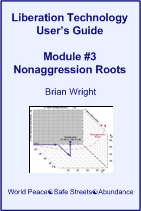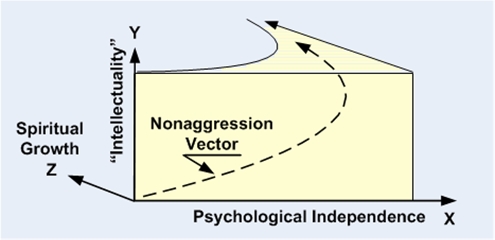

 |  |
SNaP Module #3: Nonaggression Roots
|
Please go to the new Coffee Coaster site implemented more gracefully in Wordpress. This page @ http://brianrwright.com/CoffeeCoasterBlog/?p=3265 |
 Nonaggression Roots is the third installment of a series of seven that describe and propose the Sacred Nonaggression Principle (SNaP)[1]—my book advocating that we hold the nonaggression principle (banning the initiation of physical force) as the highest moral standard in social systems.
Nonaggression Roots is the third installment of a series of seven that describe and propose the Sacred Nonaggression Principle (SNaP)[1]—my book advocating that we hold the nonaggression principle (banning the initiation of physical force) as the highest moral standard in social systems.
This particular book—which is actually a 28-page, easy-to-read booklet—proceeds from Module #2: Nonaggression 101 into identifying the psychological sources for movement of individuals or society as a whole toward the nonaggression ideal... which is our destiny. Even though Module 2 represents a proof of the NaP. showing it to be "sacred," it doesn't give a background psychologically for:
This is the book that provides the psychological background for the above key questions, which are then actually answered in Module #4: The Barrier Cloud. What I mean by psychological background is the qualities of a normal person that tend to move him along the 'Nonaggression Vector.' This is the module in which the SNaPstrip is developed as an analytical tool for mapping where we are and understanding the direction we wish to travel relative to the nonaggression ideal.
Nonaggression Roots identifies scientific foundations in human psychology, or at least a reasonable working hypothesis of those foundations, for grasping the Sacred Nonaggression Principle—what it derives from in a person and what actions promote it in society. I made the decision to break the SNaP book—published via Lulu—into seven distinct "modules..." for the younger, who do not like to read long stuff, and for the older, who find it difficult to read long stuff. These are the seven standalone modules, each approximately 28 pages:
The book size is now 5.5" by 8.5" (vs. std. 'paperback' 4.250 x 6.875) and text size was also increased to 13 point Times Roman, with plenty of spacing. Then, in keeping with the whole goal of approachability and usability, I conceived of the set of documents as a series of stepped-learning training manuals, each addressing a fundamental area of understanding and/or action about the SNaP. Hence, the tongue-in-cheek title for the series: Liberation Technology User's Guide. Finally, I changed publishers from Lulu to Amazon's Createspace, to take advantage of automated ISBN assignment and much wider sales opportunity.[2]
The third module of the SNaP or Liberation Tech series gets more deeply into what I call the SNaPstrip, a three-dimensional scheme for plotting progress of an individual consciousness (and individuals' consciousnesses) toward the nonaggression ideal. The SNaP diagram or SNaPstrip is illustrated in the figure below:

For simplicity the names of these psychological property axes are changed to X:Heart, Y:Mind, and Z:Soul. Described briefly as follows:
The remainder of the chapter works up a survey of questions, both general and specific, that indicate where one lies on each of the axes. This 'quiz' is comparable to the World's Smallest Political Quiz mentioned in Module #2: Nonaggression 101, only the SNaPstrip plot (SNaPplot) is instead a predictor of one's political leanings based on one's answers to the psychological questions. It can be a tool of self-discovery, too. This module makes a good transition to the next one, the Barrier Cloud module, which is decisive for understanding the causes and cures of the main obstacle to human liberty.
[1] Sacred Nonaggression Principle: the idea that eliminating the initiation of force from human relationships is our highest calling in a social context.
[2] As of this review, the first six modules have been published and are available on Amazon.com. Module #7 is scheduled for completion by April 1, 2011, as is the Amazon-published version of the Sacred Nonaggression Principle (all seven modules combined).
###
2011 February 18
Copyright © Brian Wright | The Coffee Coaster™
Nonaggression Roots | Nonaggression Principle | SNaP | Liberation Tech 3
###
| Publish Fee: $25 Donation |  |
Please donate $1 for download of PDF | ||